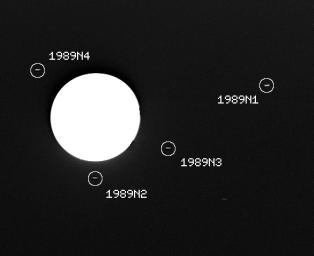
|
Neptune - Three New Satellites
- Click the image above for a larger view
- Full-Res JPEG (545 x 445) (18.4 kB)
- Full-Res TIFF (545 x 445) (81.8 kB)
Caption:
This image captured by the Voyager 2 spacecraft was used to confirm the discovery of three new satellites orbiting Neptune. The 46 second exposure was taken by Voyager 2's narrow angle camera through a clear filter on July 30, 1989, when the spacecraft was about 37.3 million kilometers (23.6 million miles) from Neptune. The large globe of the planet itself is severely overexposed and appears pure white. The image has been computer processed to accentuate the new moons, which otherwise would appear little stronger than background noise. The satellite 1989 N1, at right in this frame, was discovered by Voyager 2 in early July 1989. The new satellites confirmed this week are 1989 N2, 1989 N3 and 1989 N4. Each of the moons appears as a small streak, an effect caused by movement of the spacecraft during the long exposure. The new moons occupy nearly circular and equatorial orbits ranging from about 27,300 to 48,300 kilometers (17,000 to 30,000 miles) from Neptune's cloud tops, and are estimated to range in diameter from about 100 to 200 kilometers (about 60 to 125 miles).
Background Info:
The Voyager Mission is conducted by the Jet Propulsion Laboratory for NASA's Office of Space Science and Applications.
Cataloging Keywords:
| Name | Value | Additional Values |
|---|---|---|
| Target | Neptune | Proteus, Thalassa |
| System | Neptune | |
| Target Type | Planet | Satellite |
| Mission | Voyager | |
| Instrument Host | Cassini Orbiter | Voyager 2 |
| Host Type | Orbiter | Flyby Spacecraft |
| Instrument | Imaging Science Subsystem (ISS) | |
| Detector | Narrow Angle Camera | |
| Extra Keywords | Grayscale, Visual | |
| Acquisition Date | ||
| Release Date | 1999-07-25 | |
| Date in Caption | 1989-07-30 | |
| Image Credit | NASA/JPL | |
| Source | photojournal.jpl.nasa.gov/catalog/PIA01991 | |
| Identifier | PIA01991 | |
